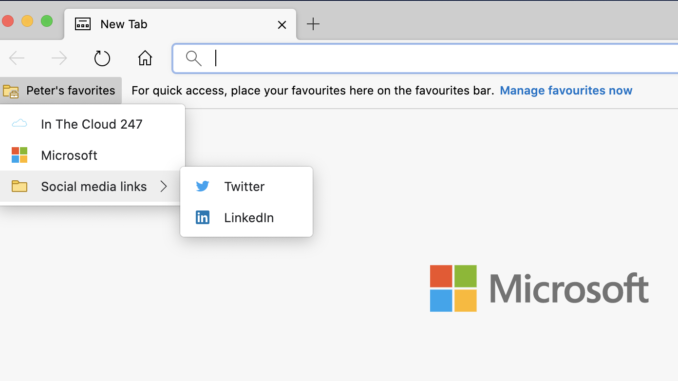
In my previous post I showed how to control managed favorites for Edge with Microsoft Intune, but that was for Windows devices. In this post I show how we can control these favorites for macOS.
For macOS there are some more steps involved in controlling these favorites, compared to how we control it for Windows. For macOS we need to created a configuration file (plist file), which we can deploy as a custom configuration policy in Intune.
Create the plist files
To deploy custom settings to macOS we need to have a property list (plist) file which we can deploy with a custom configuration policy. An example plist file is provided by Microsoft on the Edge for business page, where you can also download several different installer files.
Choose a channel, build and macOS as platform and download the policy files for the example plist file.
The file can be easily edited On Windows by using a text editor like Notepad++ or on macOS with an application like Xcode. Before we can deploy it we need to convert the file to a mobileconfig file. This can be done for example by using mcxToProfile, which can be downloaded from GitHub.
To get an overview of all the available settings, start the Edge browser on your Mac and type edge://policy in the search bar.
Search for favorites to get an overview of all settings related to favorites. Or search direct for managedfavorites as that is the setting we need.
If you click on managedfavorites, your redirected to Microsoft Docs.
Here you find some information related to the policy setting, like the data type. In this case Dictionary.
A dictionary is actually a collection of different values (in this case strings) which are collected in another dictionary, which we see in the example if we scroll down on the Docs page.
If we open a plist file in Xcode we get a better overview. Below is my own edited plist file.
The managed favorites config, contains one or more arrays (two in the example) in which the favorites are configured.
The first array contains the top-level favorites.
The name of the favorites folder is put in the first dictionary (item 0). Below that we place the favorites, one by one in their own dictionary (item 1, item 2 etc).
Every favorite exists of two strings, one for the name and one for the url.
If we create a sub folder, that is the second array. In this second array we create the same structure with favorites consisting of strings for name and url.
If you`re done editing the plist file, save it to a local folder.
Convert the plist to a mobileconfig file
When we are done adding all the required favorites to the file, we need to convert the plist file to a mobileconfig file so we can deploy it with Intune. There are several apps to convert such a file, I choose mcxToProfile. mcxToProfile is a command line tool which you can run in Terminal.
As you can read on Github, this is the command to convert a plist file:
./mcxToProfile.py –plist /path/to/a/plist –identifier MyApplicationPrefs
In our case we need to specify the location to our com.microsoft.Edge.plist file and our Identifier is com.microsoft.Edge:
./mcxToProfile.py –plist ./com.microsoft.Edge.plist –identifier com.microsoft.Edge
By using com.microsoft.Edge as Identifier we make sure this will be used in file as PayloadIdentifier and in the mobileconfig filename.
Now that we have the mobileconfig file, we are ready to create a policy in Microsoft Intune (Endpoint Manager).
Create a custom configuration profile in Intune
Open a browser to sign in to the Endpoint Manager admin center.
- Sign-in to the Endpoint Manager admin center
- Browse to Devices – macOS
- On the Configuration profiles tab click +Create profile
- Choose macOS as Platform
- Choose Custom as Profile type
- Click Create
- Give the configuration profile a Name
- Enter a Description (optional)
- Click Next
- Click on the folder icon
- Select the mobileconfig file to upload it
- Enter com.microsoft.Edge as Custom configuration profile name
Click Next and finish the wizard by adding scope tags (optional) and assign the profile to a group.
The end-result
Now let`s have a look at the end-result on the macOS device.
As soon as the profile is synced to the device, we see the managed favorites folder in the Edge browser, in this example Peter`s favorites. In this folder we see the favorites and the sub folder (Social media links). In the sub folder the favorites are also created.
If we open edge://favorites from the address bar we see the favorites are managed; Favorites are managed by your organization.
By opening edge://policy from the address bar, we see all our managed policies, including the managed favorites.
That`s it for this post. Thank you for reading.
And if you`d like to read more articles related to Microsoft Edge, have a look at this overview.

Do you have any updates for 2023 as this article is no longer accurate. I have made multiple attempts at this and all have failed. I am using the latest masOS as of this writing and a manually installed Edge browser vs deployed via Intune. This is failing on Intel and Apple silicone.
i’m on the same boat here… mcxtoprofile is not working due to issues with the referenced “foundation” module, and the alternative tool i found called meecxprofile isn’t working either.